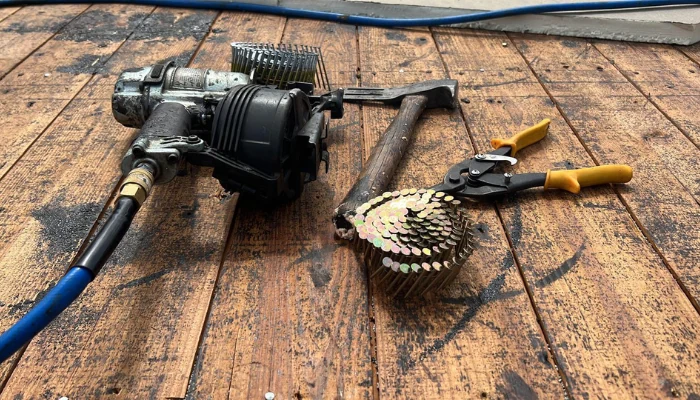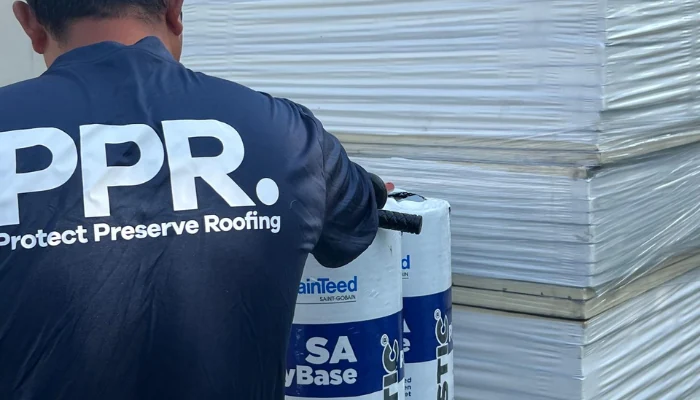The cost to tarp a roof can be a big concern for homeowners in Florida, especially during the storm season. Many people don’t realize that prices range from $800 to $1,600, depending on the size of the roof, the height of the home and how fast the job needs to be done. You need to keep in mind that this isn’t just a number, it’s about keeping your home safe in unpredictable weather.
Thousands of emergency tarp installations happen in Florida each year. These jobs don’t just involve covering up a leak. They demand quick action, careful planning and an eye for safety. That’s why so many homeowners choose to rely on professionals like Protect Preserve Roofing, who understand how to secure a tarp without creating more problems later.
You might wonder: Can I save money by doing it myself? Here’s the brutally truth: DIY can lead to bigger headaches, especially if nails or screws get involved. Some insurance companies might even deny your claim if the tarp isn’t installed the right way.
So what should you expect to pay and what are the risks of cutting corners? Let’s break it all down so you can make an informed decision that protects your home and wallet.
Average Cost to Tarp a Roof: What to Expect
When you need to tarp a roof, you’re likely asking: how much will it cost? Let’s cut to the chase. In Florida, the cost to tarp a roof typically ranges between $800 and $1,600 or even more. These numbers come straight from Protect Preserve Roofing’s experience in handling emergencies with skill and speed.
The reality is that prices change based on a few things:
- Size of the roof: Bigger roofs need more tarp and labor.
- Height and pitch: Steeper or higher roofs require more time and special equipment.
- Damage extent: Heavier damage might mean extra work to secure the tarp properly.
- Timing: If it’s raining and you’re calling last-minute, the urgency can push the cost to the higher end.
A quick breakdown:
- Small roof (under 500 sq. ft): $800 – $1,000.
- Medium roof (500–1,000 sq. ft): $1,000 – $1,400.
- Large roof (1,000+ sq. ft): $1,400 – $1,600+
These are real numbers from real jobs. No guesswork because at Protect Preserve Roofing, we aim to be transparent and fair to protect your home fast.
Pro tip from your friend Protect Preserve Roofing: Don’t nailing or screwing tarps, unless there’s no other option. It can void insurance claims or damage the structure. We always choose safe, insurance-friendly ways to secure tarps, even when the pitch is steep.
Regional Pricing: Florida’s Unique Challenges and Costs

Florida isn’t just hot, it’s a unique puzzle for roof tarping. Between daily rain showers, hurricane threats and brutal sun, the state pushes tarps (and the people installing them) to the limit.
How Florida weather impacts the cost to tarp a roof
Those heavy afternoon downpours and sudden tropical storms make quick fixes essential. That’s why the average cost to tarp a roof in Florida typically runs from $800 to $1,600 for standard tarping jobs.
If you’re wondering how much does it cost to tarp a roof during hurricane season, brace yourself: prices often jump as demand for emergency work spikes.
Timing is everything
Hurricane season brings more than rain, it brings urgency. Contractors and crews hustle to keep homes dry, but this rush can push prices higher. That’s why timing your repairs early can save you some serious cash.
Florida’s building codes: the hidden cost Factor
Florida’s building codes are strict and for good reason. They’re designed to keep you safe when storms hit hard.
However, cutting corners with cheap tarps or sloppy installs can void your insurance or cause even more damage. That’s why working with pros who know the local rules – like Protect Preserve Roofing – isn’t just smart, it’s essential.
It’s more than a quick cover-up
Some folks think it’s just about slapping a tarp on the roof and calling it a day. In Florida, it’s never that simple. Doing it fast and doing it right can mean the difference between minor damage and a nightmare insurance claim.
Remember: It’s not just about covering a hole. It’s about doing it right, fast, and safe because one wrong move can mean water damage or a denied insurance claim.
Breaking Down the Costs to Tarp a Roof: Materials, Labor and Extras
Let’s get into the numbers. The total cost to tarp a roof usually falls between $800 and $1,600 or more for a typical home in Florida. Here’s how that breaks down:
| Item | Estimated Cost |
|---|---|
| Materials (tarps, sandbags, wood battens) | $150 – $400 |
| Labor (installers, safety measures) | $300 – $800 |
| Emergency Surcharges | $100 – $400 extra |
| Special Conditions (steep pitch, large roof) | +$200 – $400 extra |
Some factors that affect the cost to tarp a roof
Several key factors can swing your tarp costs up or down:
- Roof size and pitch: A steeper, taller roof takes more time and care.
- Damage severity: Big holes or tricky areas need stronger materials and careful work.
- Urgency and weather: If the rain’s pouring or a storm’s coming, you’re paying for speed.
- Material type: Basic poly tarps cost less, while heavy-duty ones built for Florida’s harsh sun and storms cost more.
Important reminder: Never nail or screw a tarp straight to your roof. That can wreck your shingles and void your insurance. The pros at Protect Preserve Roofing secure tarps with sandbags, wood battens, so your roof stays safe and your coverage stays intact.
Tips to keep the cost to tarp a roof low without cutting corners
- Schedule regular roof i: Stay ahead of leaks and minor damage. The sooner you catch a problem, the cheaper the fix.
- Maintain your gutters: Clean gutters mean less water pooling on your roof. This reduces the chance of sudden leaks and the need for last-minute tarping during a storm.
- Choose the right season: If you can plan ahead, schedule any tarping work before peak hurricane season. Prices are often lower when demand is lower.
- Hire a local pro: Protect Preserve Roofing know the local weather and codes. What means fewer mistakes, faster work, and no extra costs from re-doing jobs that aren’t up to standard.
- Avoid DIY disasters: While it might seem cheaper to throw up a tarp yourself, slipping or using the wrong fasteners can cause more damage – what costs more. Trust the experts to do it safely and within insurance guidelines.
- Check your insurance policy: Some homeowners’ insurance plans cover temporary repairs after storms. Know what’s in your policy.
- Stay on top of maintenance: A well-maintained roof can handle storms better. That means fewer emergencies, fewer tarps and more money in your wallet.
DIY Risks vs. Hiring a Pro

You might think you can save a buck by slapping a tarp on your own roof. Let’s be real, it’s tempting. But here’s what you need to know.
DIY risks:
- Slippery surfaces can lead to falls and injuries.
- Using nails or screws to secure the tarp can damage your roof and make your insurance company say “no thanks” to any future claims.
- Poorly secured tarps can blow off or let water in, making things worse.
So, why hiring a pro makes sense? Because Protect Preserve Roofing doesn’t just throw a tarp up there. We secure it safely without damaging your roof and we know how to handle Florida’s winds and rain. We also have insurance-friendly methods that protect your coverage.
Hiring us saves you from surprise costs and stress later. Plus, you get it done fast. No waiting for a break in the weather or risking a trip to the emergency room.
Insurance and Tarping Costs: What You Need to Know
Many homeowners wonder, “Will my insurance cover the cost of tarping?” The answer isn’t always simple, but we will explain the essentials so that the main doubts are removed.
Will insurance cover it?
- Most homeowners’ policies will pay for emergency tarping after a storm.
- The coverage depends on the cause of the damage and your specific policy terms.
- It’s wise to talk to your insurance agent before making a claim.
Why proper installation matters?
Insurance companies often won’t cover damage if the tarp is nailed or screwed directly into the roof. That’s why we at Protect Preserve Roofing use sandbags or weighted systems whenever possible. It’s safer for your home and keeps your insurance valid.
Proper Installation Methods to Avoid Insurance Headaches
We know that securing a blue tarp is more than just slapping it on a roof. Let’s be straight here: insurance companies frown upon tarps nailed or screwed into your shingles. It can void your policy and lead to bigger headaches later.
What’s the safer way?
- Use sandbags or other weight systems to hold the tarp down.
- Avoid using nails or screws unless the pitch is so steep that no other option works.
- Only consider direct fasteners if your roof is so damaged it’ll need a full replacement anyway.
How Protect Preserve Roofing does it: We take insurance concerns seriously. We use safe methods that comply with your policy. This way, you stay covered and your roof stays protected until real repairs can happen.
Conclusion: Why Choose Protect Preserve Roofing in Florida?
Florida’s weather is unpredictable. Sudden storms can tear up roofs and leave homes exposed. That’s why having the right partner matters. At Protect Preserve Roofing, we’re more than just a quick fix.
With top-notch materials and skilled workers to install tarps safely, we respect insurance guidelines and we know Florida’s weather because we’ve been helping homeowners like you for years.
Don’t roll the dice on your roof. We can schedule an appointment to examine your roof. You can get a quick estimate, or you can call us.









